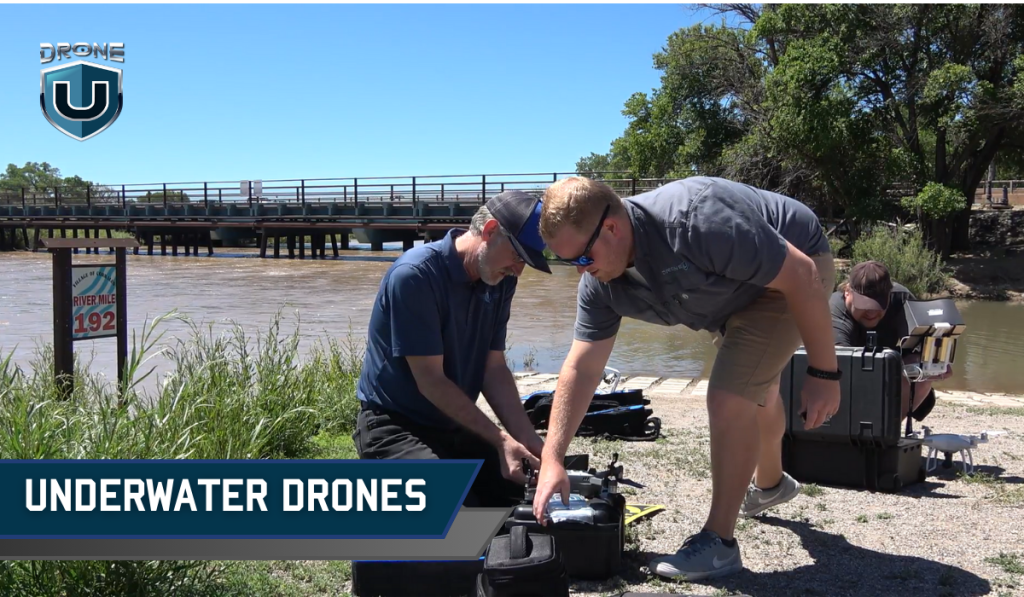
Ever dreamed of swimming alongside coral reefs, exploring the beauty of shipwrecks, or the sea world – all from the comfort of dry land? Underwater drones, also known as Unmanned Underwater Vehicles (UUVs), are making this a reality. These innovative machines are shifting the way we experience the underwater world.
In this guide, we’ll dive deep into the world of underwater drones and uncover the top 7 drones in the market.
First, let’s take a look at the brief history of underwater drones.
History of Underwater Drones
Autonomous Underwater Vehicle (AUV) development began in the 1950s and has seen continuous advancements. Here’s a timeline of some key milestones:
1950s
The first AUV, classified as an unmanned underwater vehicle (UUV), emerged in the United States in 1957. The University of Washington designed the Special Purpose Underwater Research Vehicle (SPURV) to gather oceanographic data in Arctic waters.
1980s
The 1980s witnessed the merging of ROV (Remotely Operated Vehicle) technology with AUV capabilities. In 1983, ISE Ltd. and International Submarine Engineering collaborated to create the Autonomous and Remote Controlled Submarine (ARCS).
1990s
The 1990s marked a shift towards longer-term underwater exploration with the introduction of solar-powered AUVs. The credit goes to the Russian Institute of Marine Technology Problems, which introduced the Solar Autonomous Underwater Vehicle (SAUV) in 1987. Furthermore, the development of gliders in 1995 revolutionized AUV technology by allowing underwater submergence for weeks or even months at a time, thanks to extended battery life.
2000s
The 2000s saw a surge in AUV usage beyond mere testing tools. The growing international user base and increased funding for AUV development led to commercial sales. This shift expanded the scope of AUVs from research-based applications to industrial and commercial uses.
2010s and Beyond
In recent years, a renewed focus has been placed on the military applications of AUVs. Following the successful use of unmanned surface vehicles (USVs) by Ukraine in the Black Sea in 2022, the Ukrainian Navy adopted the Toloka TLK-150, a small robotic submarine, in early 2023.
In April 2024, Ukraine announced testing of an “unmanned submarine” capable of carrying divers, torpedoes, and missiles, and featuring extended range and endurance.
Types of Underwater Drones
Unmanned underwater vehicles (UUVs), also known as uncrewed underwater robots. They can navigate and operate underwater without requiring a human pilot on board.
These powerful vehicles come in two main categories: remotely operated underwater vehicles (ROVs) and autonomous underwater vehicles (AUVs).
1. Remotely Operated Underwater Vehicles
ROVs are connected to a control station or ship by a cable. This cable supplies power, allows for communication, and even transmits a live video feed to the operator. This tether allows for precise human control over the ROV’s movements and actions. situations requiring real-time decision-making, such as inspecting pipelines or conducting underwater search and rescue missions.
2. Autonomous Underwater Vehicles
AUVs are self-directed vehicles. They operate on their own, without a cable linking them to the surface. They are pre-programmed with specific mission instructions and rely on built-in sensors and computer systems to navigate, collect data, and complete tasks autonomously.
AUVs are valuable for gathering data over large areas or for venturing into deep or hazardous environments where human operation might be impractical or risky. They are increasingly being used for tasks like oceanographic mapping, environmental monitoring, and underwater exploration.
Key Components and Technology
A. Propulsion Systems
Underwater drones zip through the water using special engines. These engines, called thrusters, are like tiny propellers powered by electric motors. Thrusters can be positioned in different ways (think propellers on a boat vs. a jet ski) to push the drone in any direction, allowing for sharp turns and precise movements. Some underwater drones also have buoyancy engines, which act like underwater balloons. The drone can bob up and down by inflating or deflating these engines, controlling how deep it dives.
B. Navigation and Control Systems
Navigating and controlling an underwater drone is a complex task due to the challenges posed by the marine environment. Underwater drones employ a range of sensors to gather data about their surroundings and position, including:
- Inertial Navigation Systems (INS): Combining accelerometers and gyroscopes to track the drone’s movement and orientation.
- Depth Sensors: Measuring the drone’s depth using pressure or sonar-based sensors.
- Doppler Velocity Logs (DVLs): Using Doppler shift to measure the drone’s velocity relative to the seafloor or water.
- Acoustic Positioning Systems: Triangulating the drone’s position using acoustic signals from multiple reference points.
This sensor data is processed by onboard guidance systems, which use advanced algorithms and control systems to determine the drone’s position, plan its path, and issue commands to the propulsion systems.
C. Communication Systems
Radio waves don’t travel well underwater, so drones use special tools called acoustic modems. These modems are like underwater translators, turning information into sound waves that can travel far in the water. While acoustic modems are great for long-distance chats, they can be a bit slow.
For situations where a super strong connection is needed, some drones use tethered cables. Think of these cables as underwater lifelines – they provide a steady stream of power and crystal-clear communication, but they limit how far the drone can roam.
D. Payloads and Instruments
Underwater drones can be equipped with various payloads and instruments to perform specific tasks and gather data.
Common payloads include:
- Cameras: High-resolution cameras for visual inspection, mapping, and documentation.
- Sonar systems: For seafloor mapping, object detection, and underwater imaging.
- Sampling tools: Devices for collecting water, sediment, or biological samples.
- Manipulators: Robotic arms or grippers for interacting with and manipulating objects underwater.
- Scientific instruments: Sensors for measuring water properties (e.g., temperature, salinity, pH), as well as environmental monitoring equipment.
These payloads can be customized and integrated into the drone based on the specific mission requirements, enabling a wide range of applications in various domains.
Best Underwater Drones
From our research, we have curated these seven underwater drones that give you the most bang for your buck.
1. Deep Trekker REVOLUTION ROV
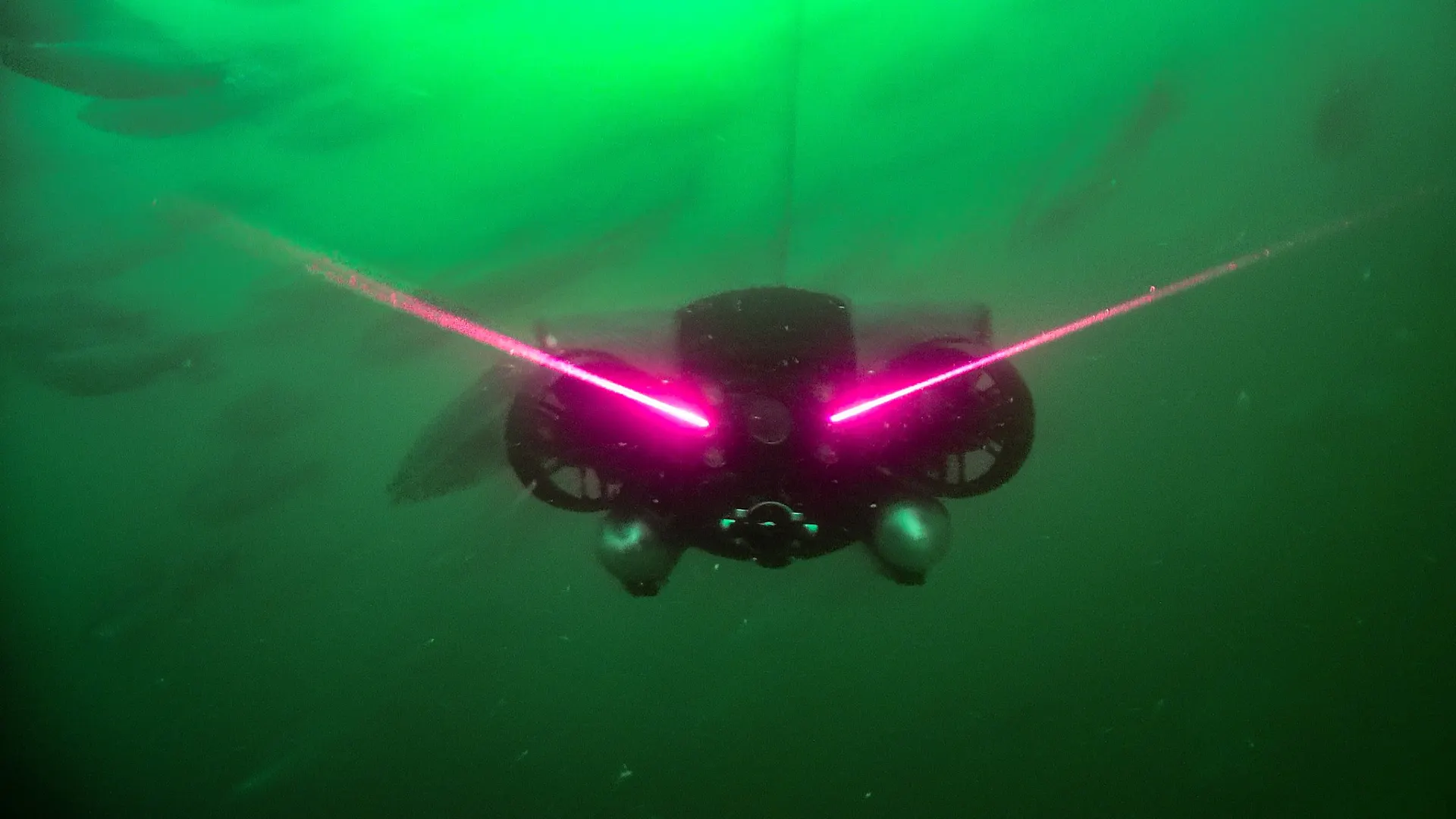 Credit: Deep Treker
Credit: Deep Treker
Deep Trekker’s REVOLUTION ROV is the ultimate deep-water explorer designed for underwater inspections and surveys, delicate target retrieval missions, and heavy-payload transportation under harsh conditions.
Specifications:
- Depth Rating: 305 meters (1,000 feet)
- Camera: 260° rotating 4k camera
- Live Viewing: Live video feed
- Tether Length: 300 meters (984 feet)
- Operating Temperature: -10°-50° Celsius (14°-122°Fahrenheit)
- Battery Life: 3-6 hours
- Control System: 7-inch LCD controller
- Movement: Six independent, reversible thrusters
- LED Lights: Four camera-facing LED lights
Pros:
- Unmatched Maneuverability: It can move vertically and laterally with precision, allowing it to navigate treacherous depths easily.
- Crystal Video Output: The REVOLUTION ROV’s 4k camera has powerful LED lights with a minimum illumination of 0.001 lux, a wide field of view, auto color correction, and enhanced clarity, making it the best underwater drone for murky water.
- Optional Features: Add-ons, including custom tether lengths, imaging sonar and water quality sensors, are available to let you soup up this underwater robot as needed.
Cons:
- Quote-Based Pricing: You must contact Deep Trekker to know how much it costs.
- Hefty construction: This drone weighs 26 kilograms in air (57 pounds).
2. CHASING Dory Underwater Drone
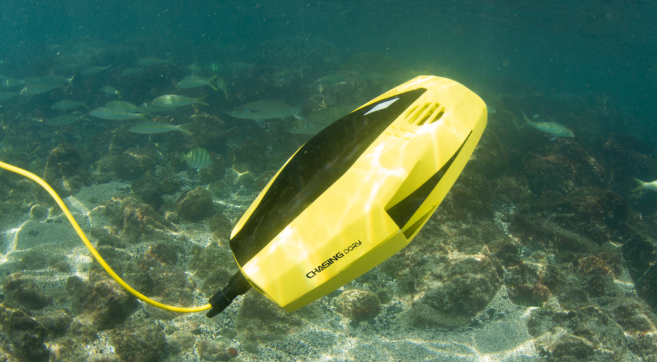 Credit: Chasing
Credit: Chasing
The CHASING Dory is your compact, maneuverable diving buddy, ready to unveil the hidden wonders of the deep. This drone dives deep, letting you see a whole new world with its high-resolution camera. Powerful LED lights illuminate the underwater environment, bringing the vibrant details to life in stunning footage.
Specifications:
- Weight: 1.1kg
- Sensor: 1/2.9 inch
- Battery Life: Up to 60 mins
- Lights: 2 x 250 lumens
- 50 feet Tethered operation
Pros:
- Compact and maneuverable design ideal for exploring tight spaces
- Excellent depth rating for exploring deeper underwater environments
- Powerful LED lights illuminate underwater scenes
- Long battery life for extended underwater exploration
- Tethered operation provides a reliable connection and power source
- Can be controlled with a smartphone
Cons:
- Can’t shoot 4K photos or videos
- Tethered operation limits freedom of movement compared to untethered drones
- Not recommended for swift current waters.
3. QYSEA Fifish PRO W6
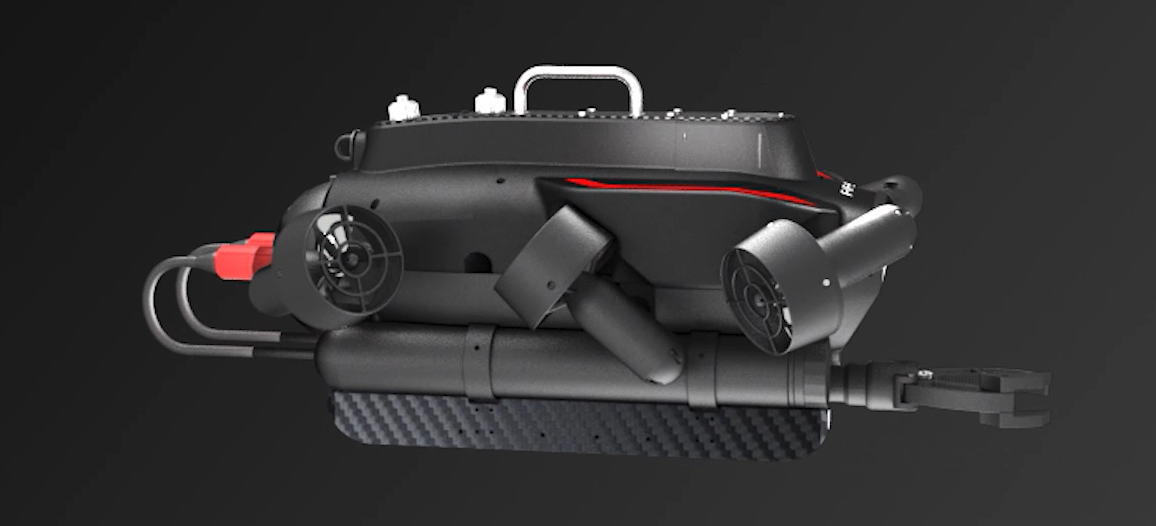 Credit: QYSea
Credit: QYSea
This industrial-grade ROV (Remotely Operated Vehicle) is built for professional use, capable of diving an impressive 1,148 feet (350 meters) underwater.
The Fifish PRO W6 is equipped with a high-tech 4K HDR camera, boasting a wide 166-degree field of view. Capture stunning, detailed footage of the underwater world in vibrant colors.
An advanced sonar system allows for 3D mapping and object detection, providing valuable data and a clear picture of your underwater environment.
Specifications:
- Depth Rating: 350 meters (1,148 feet)
- Motor System: Patented 6 Q-motor system for increased power, stability, and current-fighting performance
- Battery Life: Improved battery capacity for extended operation
- 3-axis robotic arm for object retrieval and manipulation
- Sonar array for obstacle avoidance and navigation
- Real-time underwater location tracking
Pros:
- Industrial-grade: Built for deep dives (350m) and demanding tasks.
- Powerful: Excellent maneuverability and current-fighting capabilities.
- 4K HDR camera with wide FOV: Great image quality for inspections and exploration.
- Sonar system: Enables 3D mapping and object detection for precise work.
- Modular design: Allows for adding accessories for specific needs.
Cons:
- Expensive: Pricier than most consumer drones.
- Bulkier and heavier: Less portable compared to some options.
- May be overkill: Feature-rich for casual users or basic underwater exploration.
4. PowerVision PowerRay Wizard
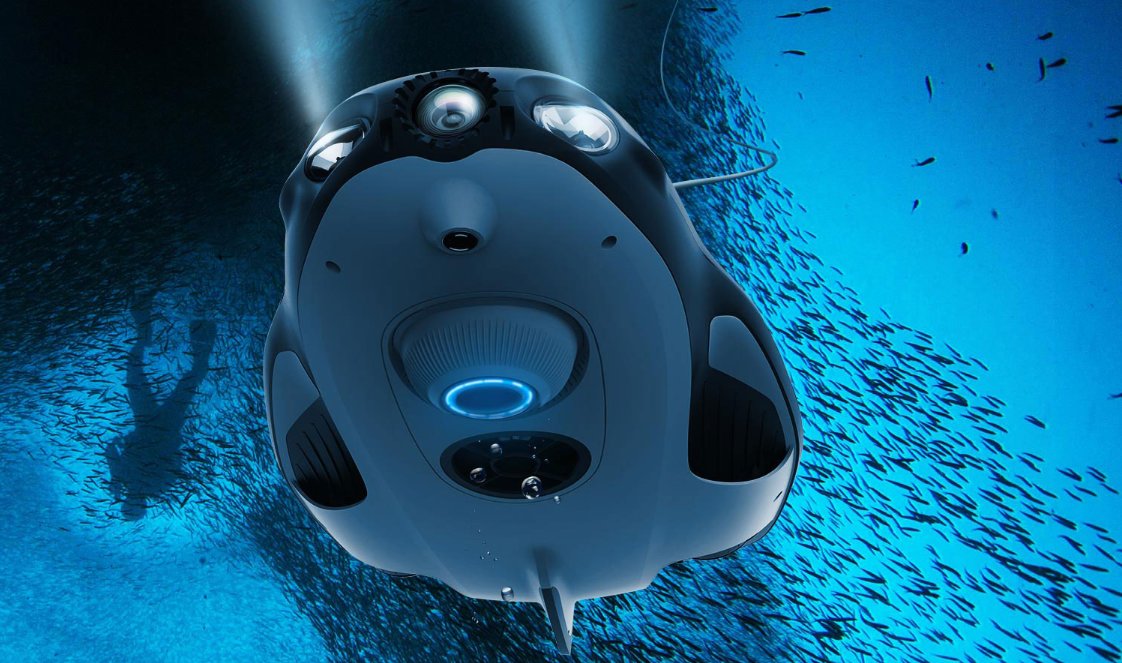 Credit: Powervision
Credit: Powervision
The PowerVision PowerRay Wizard is your underwater hunting buddy.
This easy-to-use drone dives deep, letting you explore and see what lurks beneath the surface with its stunning 4K UHD camera.
The PowerRay Wizard has a built-in sonar fish finder, making it easier to locate schools of fish. Plus, it comes with a bait drop line, letting you deploy bait directly from the drone, setting the perfect trap.
Specifications:
- Imaging: Equipped with a 4K Ultra HD camera for capturing stunning underwater videos and photos.
- Live Streaming: Allows you to share your underwater adventures with friends and family in real-time.
- Depth Rating: Reaches depths of up to 30 meters (98 feet).
- Tether Length: Operates with a tether up to 70 meters (230 feet) long, providing a good operational range.
- Battery Life: Offers up to 4 hours of operation time on a single charge.
- Portability: Compact and portable design makes it easy to carry on boats or while diving.
- Fish Finder: Built-in fish finding technology helps you locate and track fish with ease.
Pros:
- Ideal for fishing: Sonar fish finder and bait drop functionality.
- 4K UHD camera: Captures high-quality underwater footage of fish and environment.
- Easy to use: Designed for anglers with intuitive controls.
Cons:
- Pricier than some options: Not the most budget-friendly option.
- Focus on fishing: May not be ideal for general underwater exploration or photography.
- Limited depth: Dives to 100m, which might not be enough for deep-water fishing.
5. Geneinno Titan
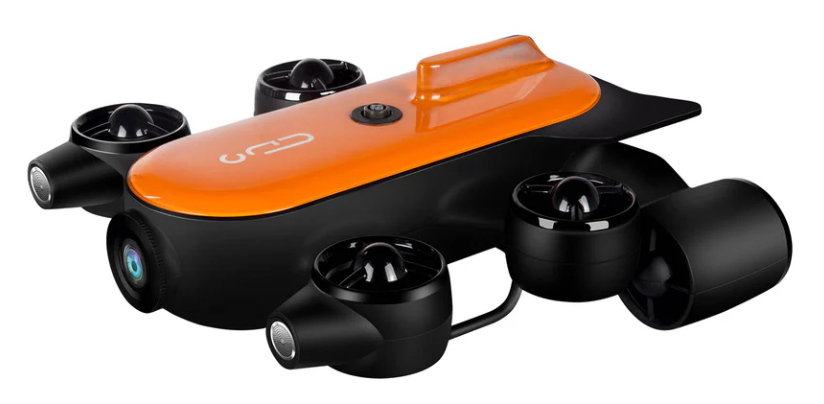
The Geneinno Titan is a mini-ROV (Remotely Operated Vehicle) designed for recreational and light professional use. This drone is a good option for underwater photography and videography. It has a 4K HDR camera with a 162-degree field of view, as well as a gimbal that helps to stabilize footage. It can also dive up to 100 meters (328 feet).
Specifications:
- Depth Rating: Reaches depths of up to 150 meters (492 feet) for the standard model, with a deeper T1 Pro version reaching 200 meters (656 feet).
- Camera: Shoots in 4K resolution at 30fps (frames per second) and also offers 1080p photo resolution.
- Field of View: A wide 160-degree field of view allows you to capture a broader underwater scene.
- Battery Life: The embedded battery provides up to 4 hours of operation time.
- Control System: Connects wirelessly to your smartphone or tablet via the Geneinno app for iOS and Android, allowing for easy control and live video viewing.
- Movement: Six thrusters enable the Titan to achieve 360-degree omnidirectional movement, providing stability and maneuverability underwater.
Pros:
- Excellent for photography/videography: 4K HDR camera with gimbal for stabilized footage.
- Good depth: Dives to 100m, suitable for exploring various underwater environments.
- Portable: Easier to transport and deploy compared to bulkier drones.
Cons:
- Not for professional use: May not have the durability or features needed for industrial applications.
- Lacks advanced features: No sonar or object detection capabilities like the QYSEA Fifish.
- Price: Can be pricier than some beginner-friendly options.
6. CHASING Gladius Mini
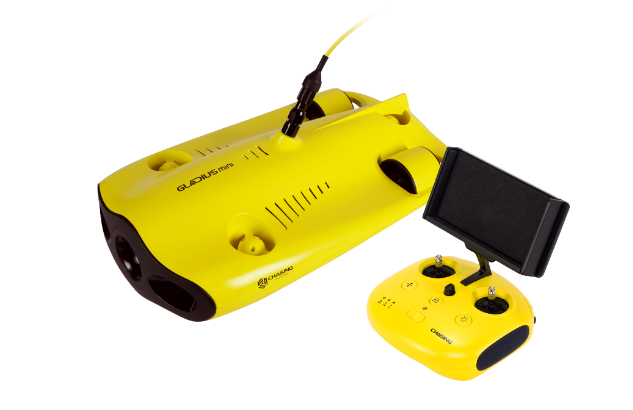
The CHASING Gladius Mini is a compact and affordable underwater drone designed for beginners and recreational use. This compact drone is easy to use and transport, making it perfect for recreational exploring. It boasts a 1080p camera that captures clear footage, and can dive as deep as 100 meters (328 feet) underwater.
Specifications:
- Depth Rating: Dives down to a maximum depth of 100 meters (328 feet), allowing you to explore a good range of underwater environments.
- Camera: Equipped with a 4K UHD camera for capturing high-resolution videos and photos of your underwater adventures.
- Live Viewing: Features a real-time viewing system that allows you to see what the drone sees directly on the controller or a connected device.
- Tether Length: Operates with a 100-meter (328 feet) tether, providing a decent operational range.
- Battery Life: Offers up to 2 hours of runtime on a single battery charge.
- Control System: Uses a wireless controller with an ergonomic design for easy and intuitive control of the drone.
- Portability: Lightweight and compact design makes it easy to transport and store.
- LED Lights: Built-in LED lights help illuminate the underwater environment for better visibility during dives.
Pros:
- Affordable: A good option for budget-conscious users.
- Compact and portable: Easy to carry and use for quick underwater exploration.
- Decent depth: Dives to 100m, suitable for exploring shallower areas.
Cons:
- Lower video quality: 1080p camera may not be ideal for professional photography.
- Limited features: No advanced functionalities like sonar or object detection.
- Might not be ideal for strong currents: Less powerful compared to some options.
7. ThorRobotics Mariana
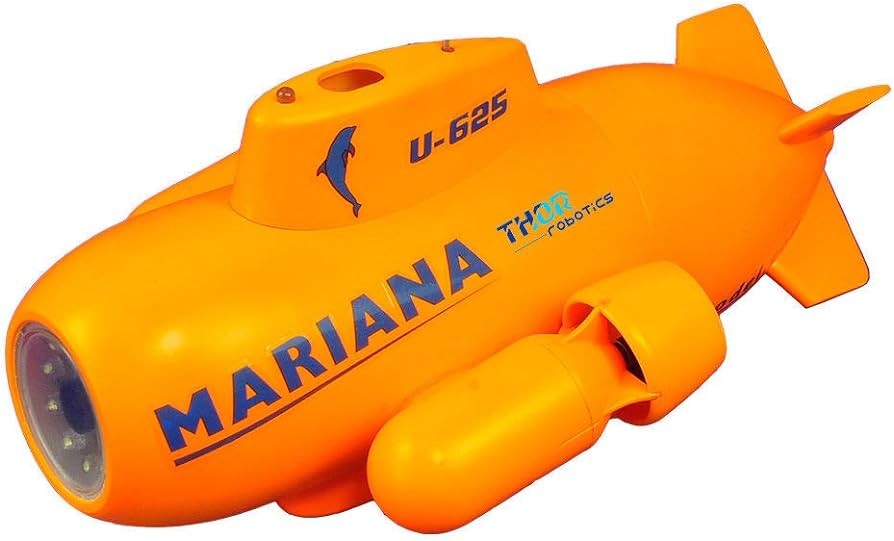
Compared to many underwater drones, the Mariana is a budget-friendly option. This makes it attractive for hobbyists or those new to exploring the underwater world.
The ThorRobotics Mariana is a mini Remote Operated Vehicle (ROV) designed for recreational use. It’s a good choice for casual exploration and underwater videography.
It boasts a 1080p HD camera, perfect for capturing crisp underwater footage. Infrared LED spotlights allow you to pierce through low-light conditions, revealing the hidden wonders of the deep. Two vector propellers provide good maneuverability, meaning you can navigate around reefs, wrecks, or other underwater structures with ease.
Specifications:
- Depth Rating: Reaches depths of up to 10 meters (33 feet), making it suitable for exploring shallow waters like pools, ponds, or calm bays.
- Camera: Equipped with a 720p HD camera for capturing underwater videos and photos.
- Live Viewing: Allows you to see what the camera sees in real-time through the included FPV goggles or a connected smartphone or tablet using the app.
- Control System: Wireless control via a 2.4 GHz remote control or your smartphone/tablet with the app.
- Portability: Compact and lightweight design makes it easy to carry around.
- Battery Life: The Ni-MH battery provides up to 1 hour of operation on a single charge.
- LED Lights: Built-in LED lights illuminate the underwater environment for better visibility.
Pros:
- Affordable: Compared to many underwater drones, the Mariana is a budget-friendly option, making it attractive for beginners or casual users.
- Good Camera: It boasts a 1080p HD camera, perfect for capturing clear underwater videos and photos.
- Low-Light Capability: Infrared LED spotlights allow you to see in low-light conditions, revealing more of the underwater world.
- Maneuverable: Two vector propellers provide good maneuverability, letting you navigate around reefs, wrecks, and other structures with ease.
- Reliable Connection: Being tethered ensures a reliable connection and steady power flow to the drone.
Cons:
- Tethered Design: Limited range due to the cable connecting the drone to the surface. If you want to explore further underwater, this might be restrictive.
- Durability: ABS plastic construction is good for recreational use, but not ideal for tougher environments. Consider sturdier materials like aluminium or titanium for professional needs.
- Limited for Professionals: The Mariana’s features and capabilities might not be sufficient for professional applications requiring high-end equipment.
Summary
Here is a summary to help you choose the perfect underwater drone based on your exploration needs:
Deep Trekker’s REVOLUTION ROV: Best drone for underwater inspections and surveys, delicate target retrieval missions, and heavy-payload transportation.
CHASING Gladius Mini: A great all-rounder for capturing high-quality footage with its versatile attachments and long range, perfect for detailed exploration.
Geneinno Titan: This option is ideal for professional use or serious underwater enthusiasts with its impressive depth capability.
PowerVision PowerRay Wizard: A top-of-the-line choice for stunning visuals, featuring a 4K camera and powerful lights to navigate even murky waters.
QYSEA Fifish PRO W6: This drone offers exceptional stability and control, making it a great pick for capturing smooth underwater videos.
CHASING Dory Underwater Drone: A user-friendly option with a good balance of features and affordability, perfect for beginners or casual explorers.
Consider the depth you want to reach, the type of footage you desire, and your piloting experience to make your choice. With the ever-evolving technology in this field, underwater drones promise to open even more doors to exploration and discovery in the years to come.
Happy diving!
Frequently Asked Questions
1. What are the disadvantages of underwater drones?
Underwater drones have the following disadvantages:
- They can be expensive.
- Battery life can limit mission duration.
- Operating in strong currents or murky water can be challenging.
- They require a tether in some cases, which can limit mobility.
2. Do waterproof drones exist?’
While some drones boast water resistance for brief splashes, drones specifically designed for sustained underwater operations don’t exist. Saltwater exposure poses a significant risk of corrosion and damage to electronic components.
3. How long do underwater drones last?
The operational lifespan of an underwater drone varies depending on the specific model and usage patterns. However, with proper care and maintenance, several years of service can be expected.
4. Does the US military have underwater drones?
The United States Navy and other military branches utilize underwater drones extensively for reconnaissance, search and rescue, and other critical missions. The recently unveiled Northrop Grumman Manta Ray exemplifies a next-generation autonomous underwater vehicle designed for extended-range military operations.
5. How deep can underwater drones go?
Underwater drones can reach impressive depths. High-performance research models can operate several kilometers below the surface. The maximum depth achievable by a particular drone depends on its design and construction materials.







Add Your Comment